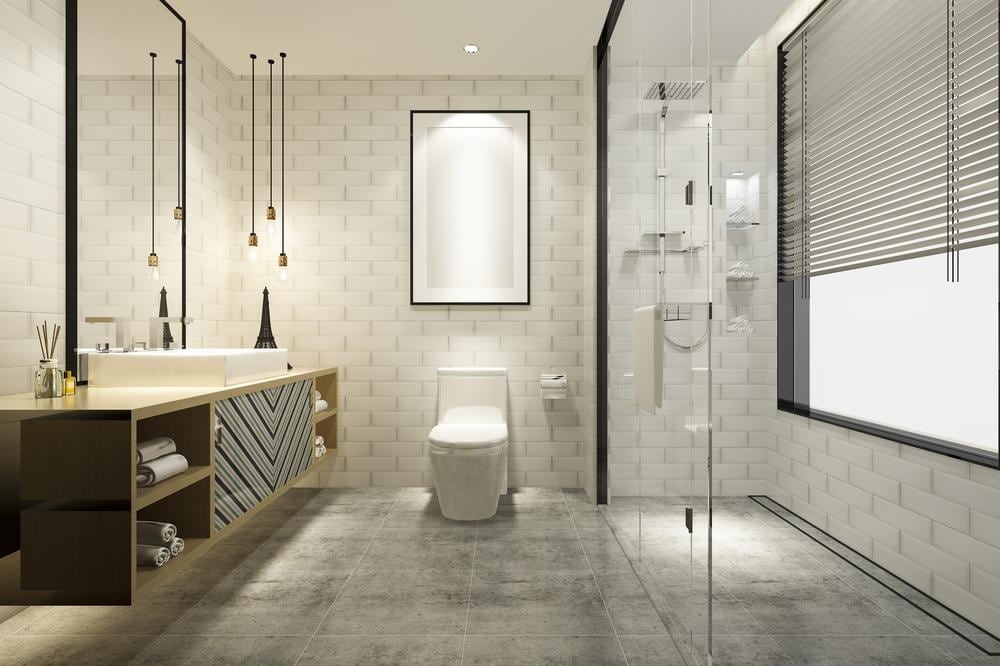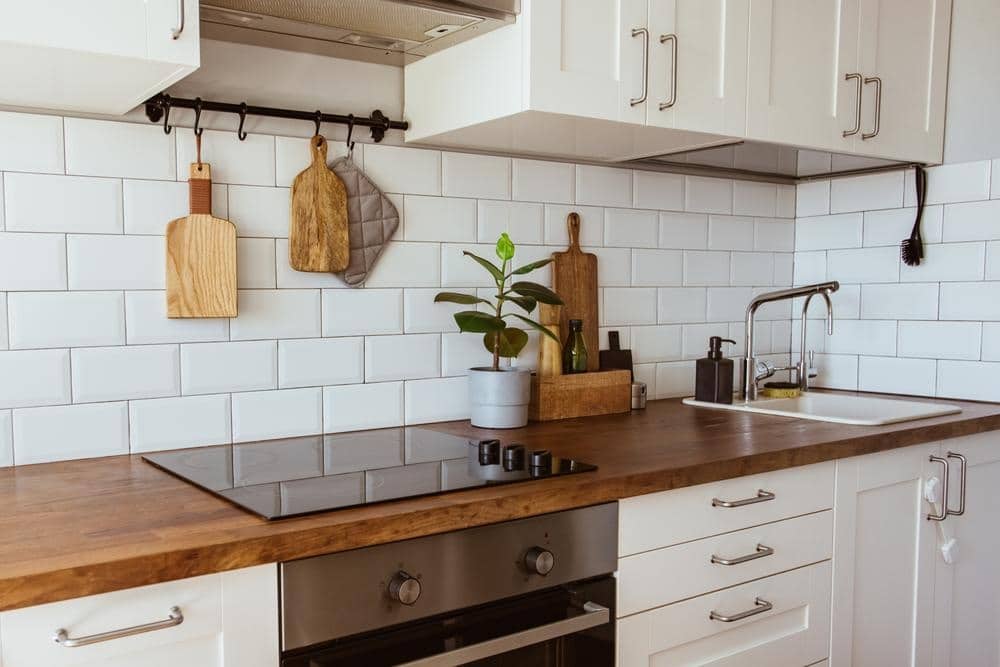Looking for inspirational bathroom floor tile ideas to add style, design, and beauty to your home? Whether you’re a homeowner trying to spruce up your existing bathroom or a contractor working on an upcoming project, we can help. With so many options in the market today, deciding what will look best in your space can be hard.

We’ve taken the liberty of breaking down different types of floor tiles, their properties, and how you might use them to inspire some grand ideas for any project type!
Table of Contents
Patterned Porcelain Tiles
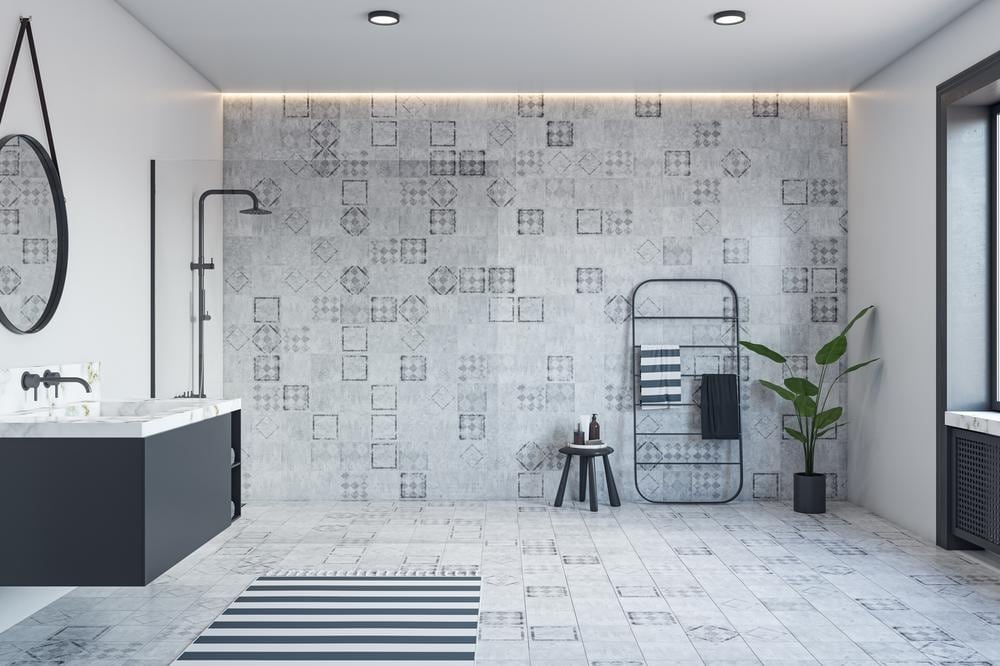
Patterned porcelain tiles have become popular flooring options, and they are ideal for homeowners who love bold and vibrant designs. These tiles come in a collection of materials, colors, and patterns, making it easy for you to choose the one that suits your taste. They are easy to clean, and their durability ensures longevity throughout the years.
Mosaic Tiles
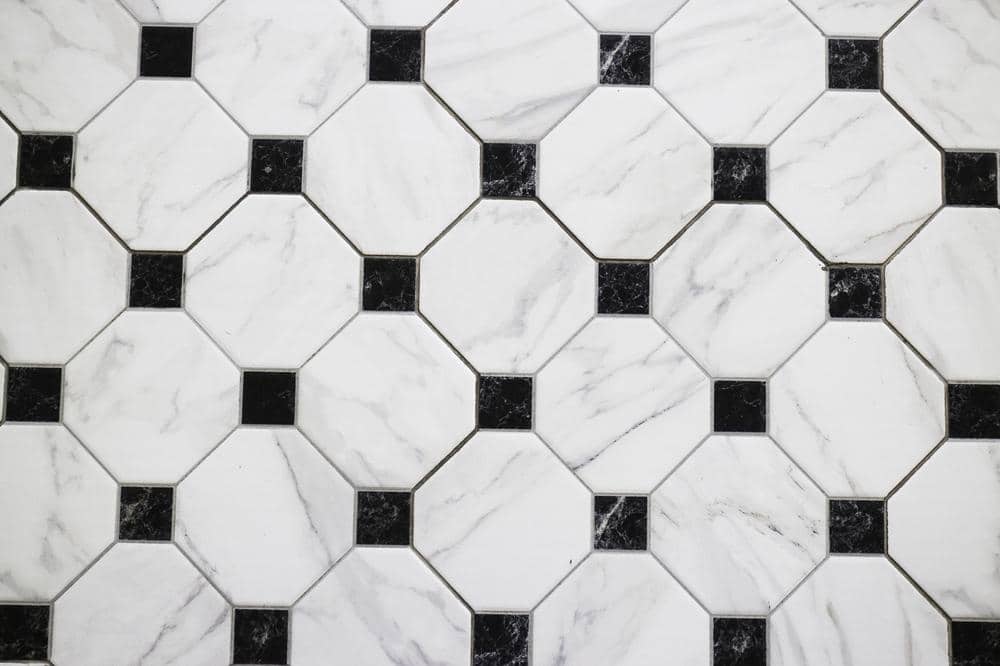
Mosaic bathroom tiles consist of small pieces of ceramic, glass or natural stone cemented together to create a striking appearance. These tiles can be arranged in captivating patterns, making them ideal for creating beautiful bathroom flooring designs. They are long-lasting and offer a luxurious look to any bathroom.
Herringbone Tiles
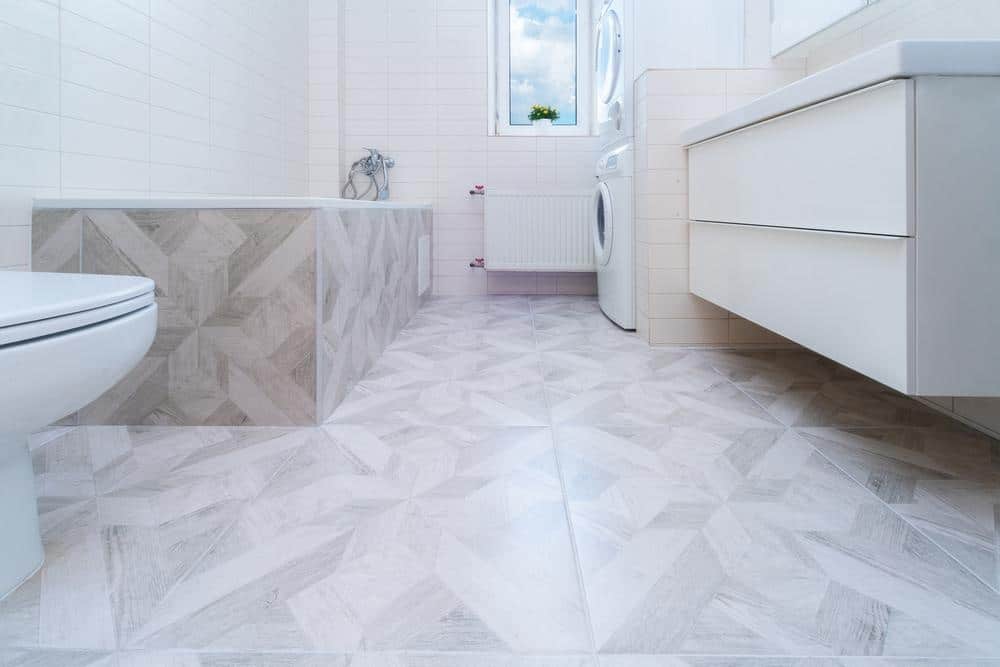
Herringbone tiles are trendy flooring options with a unique pattern resembling fish bones. These tiles are suitable for traditional and contemporary bathrooms and provide an illusion of a larger space when laid out correctly. Use lighter colors to give your bathroom a more welcoming and spacious appearance.
Hexagonal Tiles

Hexagonal tiles come in many shades, making them ideal for homeowners who like to add unique looks to their bathrooms. These tiles provide a distinctive appearance, whether used in a traditional or modern interior space. You can use these tiles to create captivating floor patterns or add a statement using contrasting colored grout.
Marble Tiles

Marble tiles are timeless and perfect for homeowners who want a classic and high-end look in their bathrooms. These tiles come in a range of colors, from dark greys to light creams to give you an expansive variety to choose from. Although marble tiles require extra care, they offer a luxurious look, making them a perfect addition to any home.
Wood-look Tiles
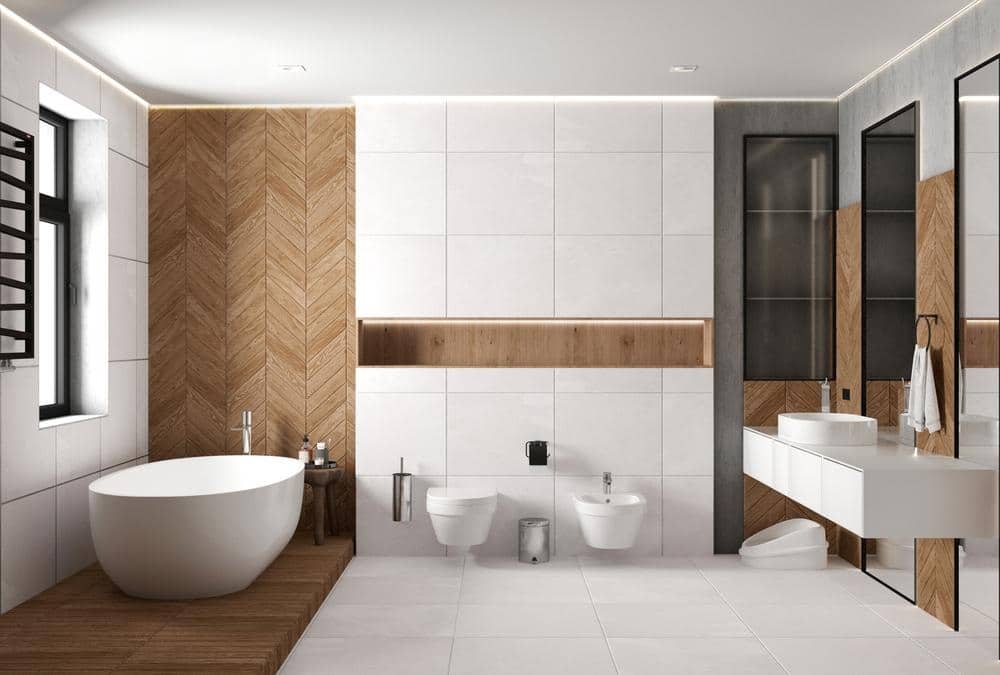
Wood-look tiles offer a natural hardwood appearance without the risk of moisture damage. These tiles are durable, easy to clean, and suitable for any bathroom, from modern to traditional settings. Choose from a range of hues, from light to dark colors to give your bathroom a rustic yet elegant look.
Ceramic Tiles
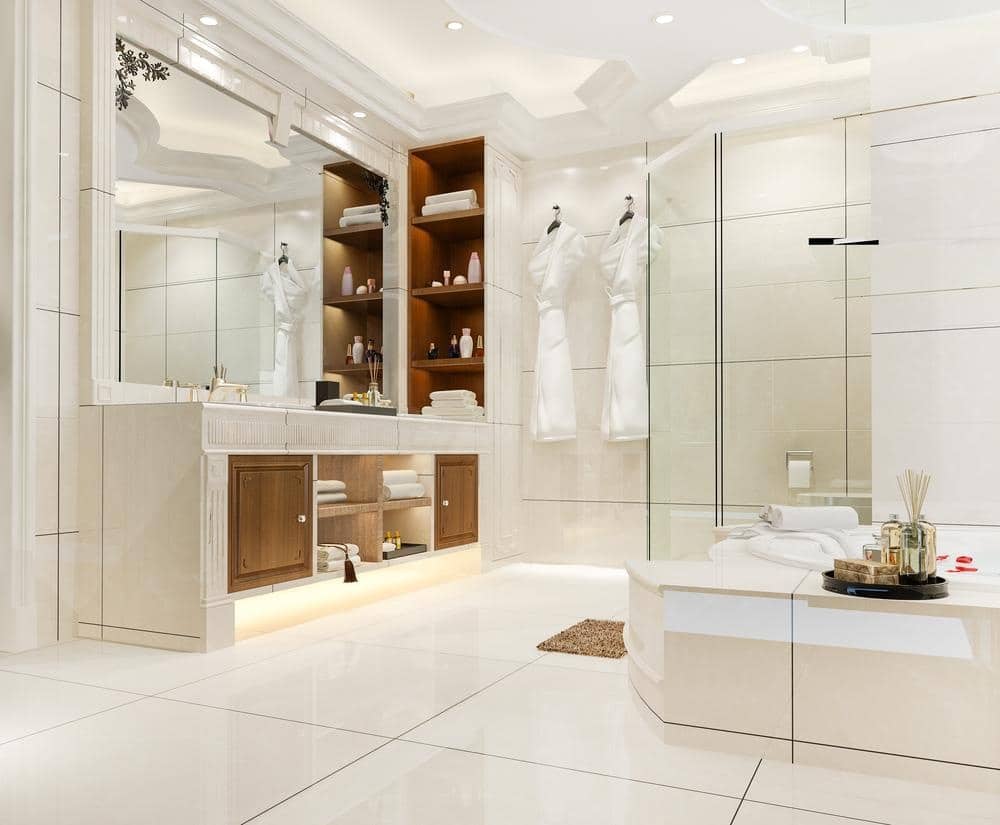
Ceramic tiles are affordable and practical flooring options for bathrooms. They offer a wide variety of colors, designs, and sizes, making them a popular choice for homeowners. Ceramic tiles are also easy to install, making them a perfect choice for a DIY bathroom renovation.
Bathroom Floor Tile Ideas For Small Bathrooms

When it comes to small bathroom spaces, every detail counts. The power of a perfectly designed bathroom floor tile can make all the difference in creating a polished and functional space. Using the right combination of color, shape, and pattern, you can enhance the illusion of space and make your bathroom appear larger than it is.
So, whether you opt for classic ceramic tiles or something more contemporary like hexagon or herringbone designs, take the time to consider which bathroom floor tile ideas will work best for your small bathroom.
Bathroom Floor Tile Ideas Black And White
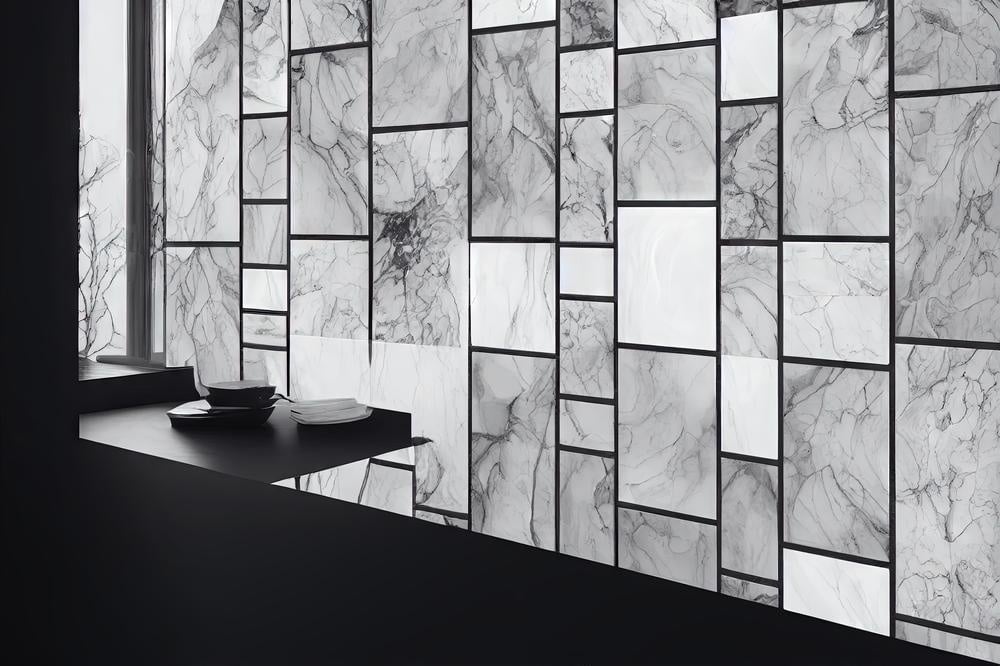
Black and white bathroom floor tiles offer a classic, elegant look that can transform any bathroom. These timeless tiles can make even the smallest of bathrooms feel bigger by creating a clean and cohesive atmosphere. There are a variety of patterns and styles to choose from, such as geometric shapes, checkerboard patterns, or intricate mosaics.
You can choose a more traditional approach or a modern twist on a classic design. Black and white tiles can also be combined with other materials, such as marble, wood, or concrete, to add extra texture and interest to your bathroom. Regardless of style, black and white bathroom floor tiles will elevate your space to the next level.
Bathroom Floor Tile Ideas Gray

Bathroom floor tiles can make a big difference in the overall aesthetic of your bathroom. And if you want to create a stylish, modern look, gray is an excellent color choice. Gray tiles can give your bathroom a sleek and sophisticated feel, so you’ll want to choose a style that matches the rest of your decor.
Plenty of gray tile options exist from simple and understated to bold and eye-catching. Whether updating a small powder room or designing a luxurious spa-like master bathroom, you will find the perfect gray bathroom tile ideas.
Bathroom Floor Tile Ideas Beige

Regarding the best bathroom floor tile ideas, beige is a classic and elegant choice. The neutral tone can create a warm and inviting atmosphere that helps to make the room feel larger and more open. There are many shades of beige to choose from, ranging from light ivory to rich mocha, so you can find the perfect tone to match your overall design aesthetic.
Additionally, beige floor tiles provide a great backing for other colors and patterns in the room, ensuring your bathroom is cohesive and well-designed. With so many benefits, it’s easy to see why beige floor tiles are popular for any bathroom remodel or update.
Bathroom Floor Tiles Design

The bathroom is arguably one of the most important rooms in the house, and choosing the right floor tiles is crucial to creating the perfect ambiance. Many bathroom floor tile designs exist from sleek and modern to rustic and natural. If you prefer a minimalist look, use simple, muted tiles in neutral colors like gray or beige.
Alternatively, opt for bold patterns or bright colors to make a statement. And don’t forget about texture! Consider tiles with interesting textures like wood grain or geometric shapes to add depth and interest to your bathroom. No matter your design, your bathroom floor tiles will set the tone for the entire space.
Bathroom Floor Tile Paint
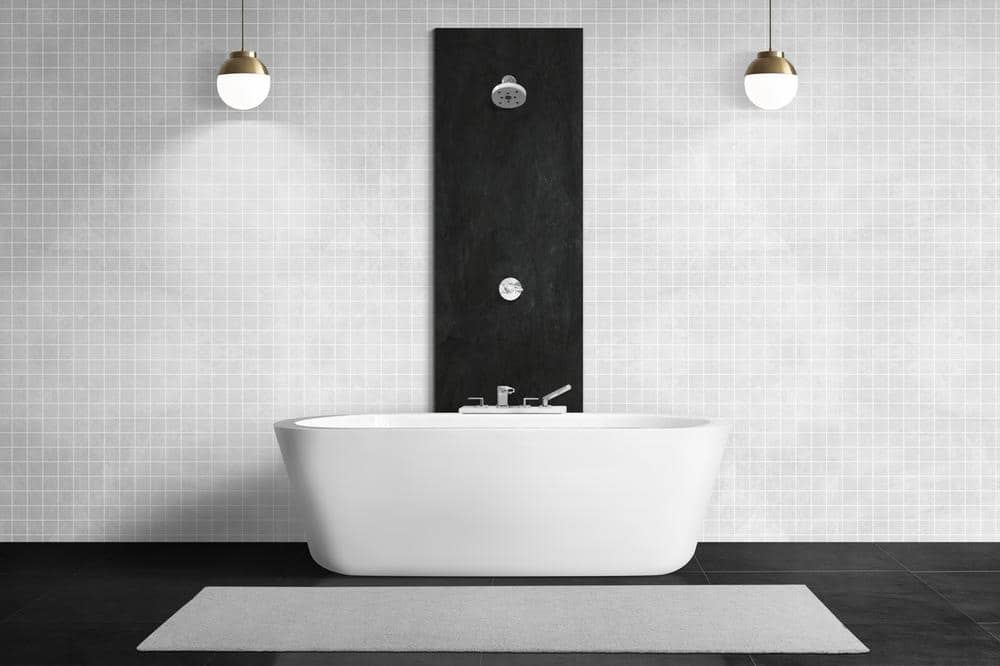
Bathroom renovations can be expensive and time-consuming. Luckily, for those looking for a quick and affordable way to spruce up their bathroom, there’s a solution – bathroom floor tile paint. This innovative product lets you easily refresh your bathroom floor without flipping out any existing tiles. With a wide range of colors and finishes, you can create a new look for your bathroom without breaking the bank.
Plus, with the added bonus of being easy to apply, bathroom floor tile paint is the ultimate DIY project for anyone looking to revamp their bathroom on a budget. Say goodbye to dull and dingy tiles and hello to a fresh new look with bathroom floor tile paint.
Bathroom Floor Tiles Vinyl
Transform your bathroom with the sleek and stylish look of vinyl floor tiles. Bathroom floor tiles can perfectly create a cohesive and functional space that suits your style and practical needs. Vinyl tiles are a great alternative to traditional flooring options as they are waterproof, durable, and easy to maintain.
With endless color and pattern options, you can make a bold statement or complement the existing aesthetic of your bathroom. Upgrade your bathroom’s functionality and beauty with vinyl floor tiles today.
Bathroom Floors Tiles
Bathroom floors are an important aspect of any bathroom design. They give the bathroom a visually appealing look and serve a practical purpose. With the wide variety of options nowadays, bathroom floor tiles provide an opportunity to showcase your personal style while adding durability to the space.
You can choose ceramic, porcelain, marble, or even natural stones like travertine, depending on your style. The tiles can be arranged in patterns, such as intricate mosaics, herringbone, or classic straight lines. When choosing your tiles, remember that they must be water-resistant and slip-resistant to ensure your safety in the bathroom.
Tile Flooring For Bathroom
If you’re in the process of remodeling your bathroom, it’s important to choose the right flooring. One popular option that looks great and withstands moisture is tile flooring. Available in various colors, patterns, and sizes, tile flooring can add a touch of elegance to any bathroom.
Plus, it’s easy to clean and maintain, making it a practical choice for busy homeowners. Tile flooring is also versatile, allowing you to mix and match various designs to create a truly unique look.
What Is The Best Floor Tile For A Bathroom?
When selecting the best floor tile for a bathroom, it’s important to consider several factors. The most important are durability, waterproofing, slip-resistance, and visual appeal.
A popular choice for bathroom floor tiles is porcelain. Porcelain offers superior water resistance to other materials like ceramic or vinyl due to its dense composition and lower absorbency rate.
This makes them an ideal choice for wetter areas in the home, such as bathrooms with frequent exposure to moisture or splashing from baths and showers. Porcelain tiles also come in many styles, shapes, sizes, and colors, making them a great option if you want something specific, like a modern style or marble look, without sacrificing performance.
What Are The Cons Of Tile Bathroom Floors?
Several potential drawbacks and cons must be considered regarding tiling a bathroom floor.
The primary con is cost. Installing tile typically requires more time and money than other types of flooring, such as linoleum or vinyl. The materials themselves can be expensive, especially if you choose higher-grade and harder-to-find tiles; the labor involved in laying out the tiles and grouting them correctly will also add significantly to the cost.
Additionally, ceramic and porcelain tiles are prone to cracking; replacing even a single cracked tile can be expensive if you have difficulty finding one with an exact match in color or pattern to your original installation.
Another con is maintenance requirements when compared against some other types of flooring options available for bathrooms – once installed properly, tile tends to require more care in terms of cleaning supplies used on it (it’s important not to use harsh acidic cleaners which could damage both the coloration and integrity of the grout itself) as well as regular resealing applications due to its porous nature which makes it susceptible to water penetration over time (especially true for high traffic areas like around showers).
Is It Expensive To Tile A Bathroom Floor?
Tiling a bathroom floor can be quite expensive, depending on the type of tile you choose and the size of your bathroom. Typically, tiles range in price from $0.50 to $30 per square foot, while larger tiles may cost up to $100 per square foot. Other necessary materials, such as grout, adhesive, and spacers, will also add to the total cost of your tiling job.
On average, it costs between $400 and $1,000 to tile a small 5’ x 6’ bathroom floor with mid-range ceramic tiles. If you use higher-end porcelain or natural stone tiles like travertine or marble, you can expect to pay anywhere from $2,500 to $4,500 for a full installation (including labor costs).
In addition to purchasing the tiles themselves, professional tile installers typically charge an additional fee for their services which can average between $3-$7 per square foot, plus any extras they might charge, such as travel fees or materials delivery fees. Installing tile yourself is one way to save money on this home improvement job. Still, unless you have experience with tiling projects, it’s best left in the hands of professionals who know what they’re doing – mistakes could be very costly in terms of time, and money spent fixing them!
What Type Of Tile Is Best For the Bathroom Floor?
When selecting a bathroom tile for your floor, several factors must be considered. First, you’ll want to choose a durable product that can withstand moisture and day-to-day wear and tear. Porcelain or ceramic tiles are great bathroom options; they’re water-resistant, easy to clean, and available in various colors and designs.
For some added flair, glass or mosaic tiles may be installed instead. If using these materials in a wet area like the shower or bathtub area, the tiles must be sealed with a waterproofing agent to avoid warping or other issues. Natural stone materials such as limestone, marble, and travertine are popular due to their unique textures. Still, they again should be regularly sealed to ensure protection against staining over time.
Regarding slip resistance, textured designs like matte ceramic or porcelain can provide additional friction underfoot, particularly when used on stairs where extra security is paramount. The size of the tile will also play an influential role in how safe your new floor looks so it’s worth bearing this factor in mind, too – larger formats generally aid overall safety, whereas smaller ones tend to make risky surfaces more hazardous overall!
What Size Tile Is Best For Bathroom Floor?
The best size tile for your bathroom floor depends on the space size and your preference. Generally, large tiles – such as 12×24″ or 16×32″ tiles – are popular for bathrooms because they create a sleek, modern look. They also reduce grout lines, making it easier to clean and maintain.
Smaller tiles can work well, too (such as 3×6” or 4×8”), but you may need to invest in more grout lines for them. This could make cleaning difficult since dirt and germs build up quickly in these crevices.
In addition to considering size when selecting tile for your bathroom floor, consider style too! Ceramic and porcelain are both good choices as they come in a range of colors and textures that can suit any design aesthetic you have going on in the rest of the room. Mosaic is another popular choice because it adds an interesting texture underfoot while providing durability against water exposure.
It’s important to remember that some extra costs are associated with materials like thin-set mortar (an adhesive used between tiling layers) when installing tile. You will also want to factor in additional expenses if you plan on hiring a professional installation team instead of doing it yourself; this is recommended if you don’t have experience laying down tile before.
What Type Of Tile Is Best For the Bathroom Floor And Shower?
The best type of tile for the bathroom floor and shower depends on various factors, such as design preferences, desired level of durability, budget, and the amount of traffic that will use the space. Generally speaking, ceramic tile is a popular choice for its versatility in both design and durability.
Ceramic tiles come in various styles to suit different décor needs and last for many years with proper care. Porcelain tiles may also be used as they are denser than traditional ceramic tile and therefore considered durable for high-traffic areas like showers and floors; however, this does come at a higher price point than traditional ceramic. Vinyl or luxury vinyl tile (LVT) can also work well depending on the amount of moisture expected due to its waterproof qualities.
Which Tile Is Best For Bathroom?
When selecting tiles for a bathroom, there are a few important factors to consider to ensure your choice is the best. Firstly, it’s important to consider maintenance and durability – tiles with a glossy finish or porcelain may be easier to clean and maintain than other materials, such as natural stone. Secondly, safety is also important; opt for slip-resistant finishes like textured surfaces to help you avoid slipping accidents in wet conditions.
Lastly, aesthetics should also play an important role when deciding on the best tile for your bathroom; choose styles that compliment your bathroom’s existing décor and pick colors that match the overall ambiance of this space.
Overall, ceramic and porcelain tiles are some of the most commonly used bathroom materials due to their resistance to water and stains and ease of installation. Regarding style, mosaic patterns or large format (single-piece) tiles are popular options that can create interesting visual effects while being relatively easy on budgets. Natural stones such as marble or granite can also be used. Still, they typically require more maintenance than other manufactured ceramic-type products due to their density and texture irregularities which may require special cleaning products/treatments over time.
What Is The Average Cost To Tile A Bathroom?
The average tile cost of a bathroom depends on several factors, including the bathroom’s type and size, the project’s complexity, geographical location, and local market rates. Generally speaking, it is possible to tile an entire bathroom (walls and floors) for somewhere between $2,000 – $5,000. However, this cost could easily be higher if you are looking at complex designs with mosaics or intricate tiles.
When considering tiling costs, there are two main components to consider:
1) Materials – Typically, wall and floor tiles range from $0.50 per square foot to around $10/sqft depending on material quality and installation requirements, such as grouting or adhesives.
2) Labor Costs – Depending on geographic location, labor costs for tiling can range from about $3-$15/sqft, including removal of existing materials (if required), installation, and cleanup. Professional tile installers may also charge additional fees for sealing grout lines or other tasks involved in finishing a project. These should be considered when budgeting your project’s total cost.
In addition to these expenses, there may also be additional associated costs depending on the specific situation, such as plumbing fixtures that need replacing during demolition; new paint required after completion; extra drywall needed because walls have been damaged during demolition; etc. ultimately, the total cost will depend greatly on all of these variables so it’s always important to get quotes first before proceeding with any renovation work.
What Is The Cheapest Type Of Bathroom Tile?
The cheapest type of bathroom tile is generally ceramic tile. Ceramic tiles are made from clay that has been fired and glazed to create a hard-wearing, watertight surface. They come in an incredible array of shapes, sizes, textures, and colors, making them an attractive choice for bathrooms.
Ceramic tiles usually range from $3 to $15 per square foot, depending on the thickness and quality of the material you select. In addition, ceramic tiles can be very cost-effective if you source them from local home improvement stores or discount outlets, as they sometimes offer great deals on bathroom tile packs or bundles.
Vinyl flooring is another popular option for cheap bathroom tiles as it can cost around half the price of ceramic and other materials such as marble or granite. Vinyl flooring typically varies between $1–$5 per square foot depending on the design chosen and its durability rating. This could be an ideal solution if you’re looking for something long-lasting but don’t want to spend too much money upfront.
Furthermore, vinyl flooring is relatively low maintenance compared to other waterproof bathroom floors. It can provide a good value alternative over time due to its ease in cleaning and upkeep requirements.
Should You Have 2 Or 3 Different Tiles In Bathroom?
The answer to this question depends on the size of your bathroom and what kind of design you’re going for. Generally speaking, two different tiles can create a more modern look, while three or more tiles offer much wider design options.
Using two tiles in a bathroom can provide symmetry and help draw the eye around in an appealing way. Having a smaller bathroom space is also great since it won’t overpower the room too much with multiple colors or patterns. An example would be using one solid tile as the main tile and adding an accent tile that provides contrast but still ties into the overall color scheme.
On the other hand, having three or more different types of tiles could give you even more visual interest depending on how they are arranged. You could opt for floor-to-ceiling subway tiles along one wall and small mosaic glass inserts near accessories like sinks, toilets, and showers/tubs! With enough creativity, each wall can be designed with its own unique pattern so that there is something original about each area of your bathroom – ultimately creating an aesthetically pleasing look with plenty of personalities!
Is It Ok To Put Vinyl Flooring In A Bathroom?
Yes, it is perfectly okay to install vinyl flooring in a bathroom. Many people consider vinyl flooring one of the best bathroom options due to its incredible durability and water-resistant properties. It is also easy to clean – you only need a damp mop or cloth.
The biggest advantage of using vinyl as your bathroom flooring material is that it’s highly resistant to wear and tear, which makes it perfect for busy bathroom environments that may receive frequent foot traffic. Additionally, Vinyl floors are stain-resistant and quick drying, so they can easily handle splashes from bathtubs and showers without sustaining damage or staining issues over time.
Vinyl also comes in endless patterns, colors, and textures, so you won’t have difficulty finding something that will perfectly match your existing décor. Depending on what type of finish you choose, the color may vary slightly between pieces, so be sure to shop around before deciding which option works best for you.
Finally, if installed correctly with proper adhesive products such as waterproof sealants or latex-based adhesives designed specifically for vinyl floors, you should have no problem keeping your new vinyl floors looking their best long into the future!
What Type Of Flooring Is Best For A Small Bathroom?
Several options are available when choosing a type of flooring for your small bathroom. However, the best option depends on your budget, lifestyle needs, and personal style preferences. Generally speaking, ceramic and porcelain tiles are popular for small bathrooms due to their durability, cost-effectiveness, and stylish appearance. Ceramic tiles come in various shapes and sizes, such as squares or rectangles, with glazed surfaces that can add texture to any space, making them ideal for use around sinks or the bathtub area.
Porcelain tile is particularly suitable in wet areas because they absorb less water than ceramic tiles giving them increased resistance against mold growth. This is especially beneficial in bathrooms where moisture tends to accumulate. If you have a larger budget, then natural stone tile might be an option as well since it offers greater longevity compared to other materials; however, since it’s more expensive, you may want to reserve its installation for larger surfaces such as walls instead of floors where frequent foot traffic can wear it down much quicker over time.
Other types of flooring material available include vinyl which is waterproof but usually not as durable; linoleum which looks good but can harbor bacteria easily; laminate wood floors, which look great but require regular maintenance; a carpet that could trap dust mites increasing allergy risks; cork that offers soft support underfoot however careful maintenance is needed so dirt won’t scratch its surface preventing renewal by sanding etc.
What Is Best Flooring For A Bathroom?
When it comes to the best type of flooring for a bathroom, numerous options are available. For starters, ceramic or porcelain tile is always a great choice. Not only does it look sleek and modern, but it also offers durability and water resistance. Plus, with its customizable patterns and colors, you can create a unique style that compliments your bathroom design.
Vinyl plank flooring is another option worth considering if you want something economical yet durable. This material looks like authentic wood, but unlike hardwood floors prone to moisture damage, vinyl planks are 100% waterproof, making them an ideal choice for bathrooms with high humidity levels.
When shopping around, check out the wear layer rating, indicating how long the floor should last in areas prone to heavy foot traffic, such as bathrooms. Natural stone floors are also popular due to their distinctive beauty and natural charm; however, they can be more expensive than other materials, so make sure you explore all your options before deciding on one type of bathroom flooring over another.
What Type Of Tile Is Best For Bathrooms?
It really depends on your style preference and budget. Ceramic tiles are among the most popular bathroom tile options due to their affordability, water resistance, and durability. They can also be stylish with glazed or textured finishes, creating a visually appealing design for your bathroom walls and floors.
Porcelain is another great option for bathrooms, as it is even more water-resistant than ceramic tiles and provides greater scratch resistance. It’s slightly more expensive but has greater longevity when compared to ceramic, making it a worthwhile investment for those looking for something special in terms of durability. Marble tiles look luxurious but require plenty of maintenance to keep them pristine, so they may not be ideal if you’re hoping for an effortless installation that looks good long-term without much upkeep!
Travertine tiles offer an earthy feel and are relatively low cost and easy to install – perfect if you want to give your bathroom a unique aesthetic without breaking the bank! They come in both polished and matte finishes that can make any room look beautiful while providing decent protection from dampness in the shower area.
Is It Worth Tiling Under Bath?
Absolutely! Tiling under your bath can be a great investment for several reasons. Firstly, tiling in general, is known to add value to your bathroom, as it gives the room a more finished look. Furthermore, by adding tiles under your bath, you are also increasing the waterproofing qualities of your bathroom- meaning that water damage will be less likely and thus render costly repairs unnecessary.
Tiles can also help insulate your restroom by keeping warm air trapped inside during wintertime and providing cooler air during the summer. This means you can save money on energy costs while maintaining a pleasant atmosphere in your bathroom all year round! Additionally, tiles are a durable material so they’ll last longer than many other materials used in bathrooms – making them worth every penny spent. You’ll especially appreciate this if you plan on selling your home at some point because buyers will appreciate seeing this superior-quality finish when comparing homes for sale!
Finally, adding tiles under the bath is an aesthetic way to enhance the appearance of any bathroom, as tiles come in multiple colors and patterns, giving homeowners plenty of options for customization that match their personal style or design preferences for their home. In short, there are numerous advantages associated with tiling underneath baths, which make it worth considering if remodeling or updating the look of one’s bathroom!
Do You Need Special Tiles For A Shower?
Yes, it is recommended that special tiles be used for the walls and floor of a shower. Special tiles are designed to withstand moisture better than regular tiles, making them more durable and long-lasting in an area with high water exposure. This will help prevent mold or mildew growth damage while providing enhanced water resistance, which can further reduce water seeping through the grout lines or underneath into other areas.
Special shower tiles also tend to be easier to clean as they have glazed surfaces and can develop a slippery surface when wet due to their smoothness. This helps minimize dirt buildup and requires less scrubbing during cleaning efforts. These special tiles often have anti-slip properties, which prevent slips and falls in wet environments while offering added protection against slipping on slick surfaces during showers.
In addition, special shower tiles often come with built–in features such as recesses for shampoo bottles, soap holders, shelves for sponges or brushes, towel bars, etc., as well as safety rails for elderly people/children who may need assistance entering/exiting the enclosure more easily. All these features provide convenience, practicality, and accessibility all at once. So overall, special shower tile solutions bring many advantages over standard ones that should be considered when renovating your bathroom space!
Which Is Better, Porcelain Or Ceramic Tile?
The debate over better porcelain or ceramic tile has been raging for years. On the surface, it looks like a simple choice as both materials are composed of clay and other naturally-occurring minerals fired at high temperatures. But, the two distinct differences can make one material more suitable for certain applications than another.
Porcelain tiles tend to be denser than Ceramic tiles because they are fired at higher temperatures (up to 2,400° F). This helps give Porcelain tile its characteristic durability and strength, making it ideal for floors where heavier traffic is expected or extreme weather conditions exist. It also makes it less likely to chip and crack when heavy objects are dropped on them than Ceramic tiles.
Porcelain’s water absorption rate is also typically lower than 0.5%, meaning it can handle moisture exposure better (especially important in bathrooms). Its non-porous nature also prevents dirt from accumulating on its surface over time, which requires less maintenance to keep clean. It also provides superior stain resistance when properly sealed each year, depending upon usage levels. On top of all this, you will find endless styles and colors offered in Porcelain, giving you many options when considering design ideas too.
What Is The Best Tile To Put In A Bathroom?
When choosing the best tile for a bathroom, there are a few things to consider. Firstly, what look do you want for your bathroom? Mosaic tiles for a vintage and classic style or sleek, modern ceramic tiles for a contemporary feel. Secondly, what is your budget? Porcelain tiles are more expensive than ceramic but are also longer-lasting and easier to maintain. Thirdly, what type of environment do you have in the bathroom? For example, showers have different demands than flooring applications due to water exposure and potential moisture issues.
Considering these factors, an ideal choice would be porcelain tile, as it is extremely durable and cost-effective when managed properly. Furthermore, porcelain offers virtually endless design options thanks to its ability to mimic other materials like wood or stone while providing superior strength against scratching or discoloration over time – perfect if you’re looking for both long-term durability and practicality! Its nonporous surface also means that the chance of mildew developing is slim, making it a great option regardless of whether your shower area has direct access from outside (e.g., no door).
Other materials like travertine can also be beautiful choices, but bear in mind that these require extra maintenance, such as sealing treatments every year or so – something not needed with porcelain tile, which can help keep costs down in the long term too! So overall, if you’re looking for an attractive yet practical material that will last through daily wear & tear, then porcelain could be the best choice for your bathroom space.
What Is The Easiest Tile To Install Bathroom?
When installing tiles in your bathroom, you have a few different options. Each type of tile has its advantages and disadvantages, so you need to consider what works best for your space and budget before deciding.
Ceramic or porcelain tiles are probably your best option if you’re looking for the easiest tile to install in the bathroom. Both types of tile are relatively easy for even novice DIYers to install due to their low weight and size. Additionally, they’re often pre-glazed, so there isn’t any additional treatment necessary before installation – just lay them out directly onto walls or floors!
Ceramic tiles are generally easier (and cheaper) than porcelain tiles because they’re made from partially fired clay with a glaze coating added on top. This makes them quite durable, although they may not be as hardy as porcelain tiles over time. Porcelain is denser and more wear-resistant than ceramic tile since it’s fired at much higher temperatures, which gives it greater strength and durability; however, this also means that it can be harder to cut into smaller pieces if needed during installation.
Which colour tiles are best for bathroom floor?
When it comes to choosing the best color tiles for your bathroom floor, you have plenty of options. Generally speaking, lighter shades are the most popular for bathroom floors as they help to create a bright and airy environment while simultaneously providing traction when walking on wet surfaces.
If you’re looking for a classic and timeless look, go with white or off-white tile colors. These will create a clean and polished look that looks great in both traditional and modern bathrooms alike. An added benefit is that this type of shade won’t show dirt easily – meaning less upkeep over time!
Gray or stone-colored tiles also work well in bathrooms as these neutral options blend harmoniously with other elements such as paint colors and countertops. Selecting texture can be just as important as selecting color when deciding what works best in your bathroom – smooth polished finishes can make smaller spaces appear larger by reflecting light nicely but matte finishes are great at concealing any imperfections in the floor’s surface.
Should bathroom floor be lighter or darker?
When it comes to choosing a color for your bathroom floor, you want to make sure that you choose something that will look good in the long run and stand up to moisture.
Darker-colored floors can work well in bathrooms since they don’t show water spots or dirt as visibly as lighter colors would. However, dark colors can also absorb more heat, making them slightly uncomfortable when walking on them barefoot. Additionally, darker-colored floors can sometimes take away from the lightness of a bathroom if not installed correctly.
Lighter-colored floors offer a fresh feeling and bring out other design elements of your bathroom while keeping it bright and airy. Generally speaking, lighter colors are easier to keep clean than darker ones since dirt is less visible; however, you may find yourself scrubbing those areas more often due to some spots being harder to cover up with a mop/cleaning product. Lighter-colored floors also tend to be colder compared to their darker counterparts – something worth considering if this is an issue where you live!
What colour floor makes a bathroom look bigger?
There are several key tactics you can apply. The first is to use light colors for walls, floors, and ceilings. Light colors tend to reflect more light around the room, creating an expansive feel that can help counteract the usually tight quarters of a bathroom. Keeping in mind that any combination of cool (blue or green) or warm (yellow or red) tones give a larger sense of space to work with.
What color floor tile is easiest to keep clean?
When it comes to floor tile, there are many different colors available. However, some colors are easier to keep clean than others. White, light gray, and beige are generally the best options for color since they don’t show dirt as much as darker colors can. Additionally, tiles with a matte finish tend to be better at hiding dirt than glossy tiles.
Do dark floor tiles make a bathroom look smaller?
Yes, it is true that dark floor tiles can make a bathroom look smaller than it actually is. Dark colors have the tendency to make an area appear constricted, so using such tiles may seem like an illusion of shrinking the space of your bathroom.

Experienced Executive Assistant with a demonstrated history of working within the furniture industry. Skilled in furniture styling, visual communication, project management, and proficiency with Adobe Creative Suite. Strong arts and design professional with a (BA) Creative Direction for furniture design focused on Industrial Design from School of the Art Institute of Chicago.

